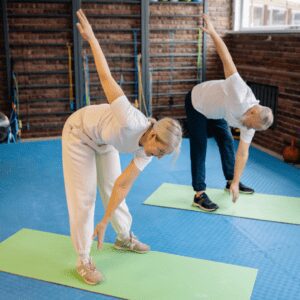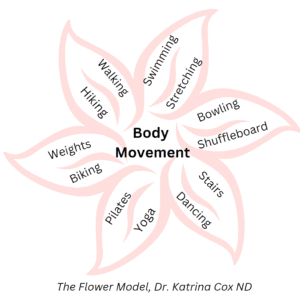Exercise is an important topic for cancer survivors wanting to improve their long-term health. Regular exercise has been shown to decrease cancer-related fatigue and cancer treatment fatigue by 30 to 50%. It also reduces the risk of cancer recurrence for some cancers. The impact that it has on our bodies is huge in terms of recovery, especially post-treatment and in remission.
It is important to acknowledge the change our physical body and muscles go through during the course of the disease of cancer and through treatment. For many, muscle strength and overall physical endurance has been lost as a result of poor appetite and food intake, metabolic processes and being more sedentary due to cancer-related fatigue. In more recent years, cancer care teams have started to encourage exercise and body movement throughout treatment to help mitigate some of these changes.
Despite this, most individuals have experienced some form of decompensation or reduced physical abilities by the time they complete treatment. For this reason, it is important for cancer survivors to include exercise as part of their cancer remission care plan.
Making Room for Movement
Does that mean you need to run out and join a gym? Not necessarily. Going to the gym can be very helpful. It can be motivating and it can provide an opportunity for socializing and connecting with others. However, it can also be overwhelming to go to the gym. There is often a lot of new equipment, and many of us don’t know where to start.
We need to break out of the “exercise happens at the gym” mindset, and instead, focus on simple ways to include more movement.
The Right “Fit” For You
 The most impactful conversation that I had around exercise was with a patient of mine that was a glioblastoma survivor. Her cancer treatment involved surgery on her brain, which had side effects that included leaving her with reduced control over the left-side of her body. Despite being an avid runner years earlier, post-treatment she was unsteady on her feet. With fitness having been a big part of her life previously, she had high expectations of being able to exercise, yet found herself frustrated by her physical limitations.
The most impactful conversation that I had around exercise was with a patient of mine that was a glioblastoma survivor. Her cancer treatment involved surgery on her brain, which had side effects that included leaving her with reduced control over the left-side of her body. Despite being an avid runner years earlier, post-treatment she was unsteady on her feet. With fitness having been a big part of her life previously, she had high expectations of being able to exercise, yet found herself frustrated by her physical limitations.
It was important to help her shift from her old way of thinking about exercise and, instead, embrace any and all small opportunities for movement. The first thing she tried was “sit-stands”. Every time she was going to sit down, she had to stand up and sit down six times. This helped her build strength, control and endurance in her leg muscles. After, we progressed by taking a lap around the living room as well.
Now, she actually walks up to seven kilometers a day. She is likely never going to run again. Unfortunately, we discovered that when she runs, it actually increases her risk of having seizures. However, by going through this movement-based exercise progression, we got her to the point where she can walk for long distances. This is something that she can continue to do, that she enjoys and that supports her long-term health.
Movement Builds Muscles
 The most important thing to remember about this physical body movement is that it involves all the muscles of the body that need to recover. It’s not just your physical skeletal muscles, but also your heart and lungs too. By using movement to activate the muscles in our whole body, we improve our endurance and physical capacity as well.
The most important thing to remember about this physical body movement is that it involves all the muscles of the body that need to recover. It’s not just your physical skeletal muscles, but also your heart and lungs too. By using movement to activate the muscles in our whole body, we improve our endurance and physical capacity as well.
What I use when I work with my patients to incorporate more body movement is something called the flower model. On that flower are petals that represent the different ways you find something that works for you. It may be going to the gym, or not going to the gym. Is it dancing in the kitchen with your friends? Is it standing up and walking in a forest? Is it jumping rope? Is it simply just going to the mailbox? Choose a “petal” that makes the most sense for you. Whatever it is that makes your body move will be the most important thing that you can do for you as a cancer survivor who wants to transform to thriving.
Remember that moving our body every day in some small way is the most important first step. So if you can do that, you are well on your way to thriving!
If you are ready to dig in deeper, learning about the cancer remission journey and supporting better health, be sure to grab a copy of my book, The Opportunity in Cancer.



